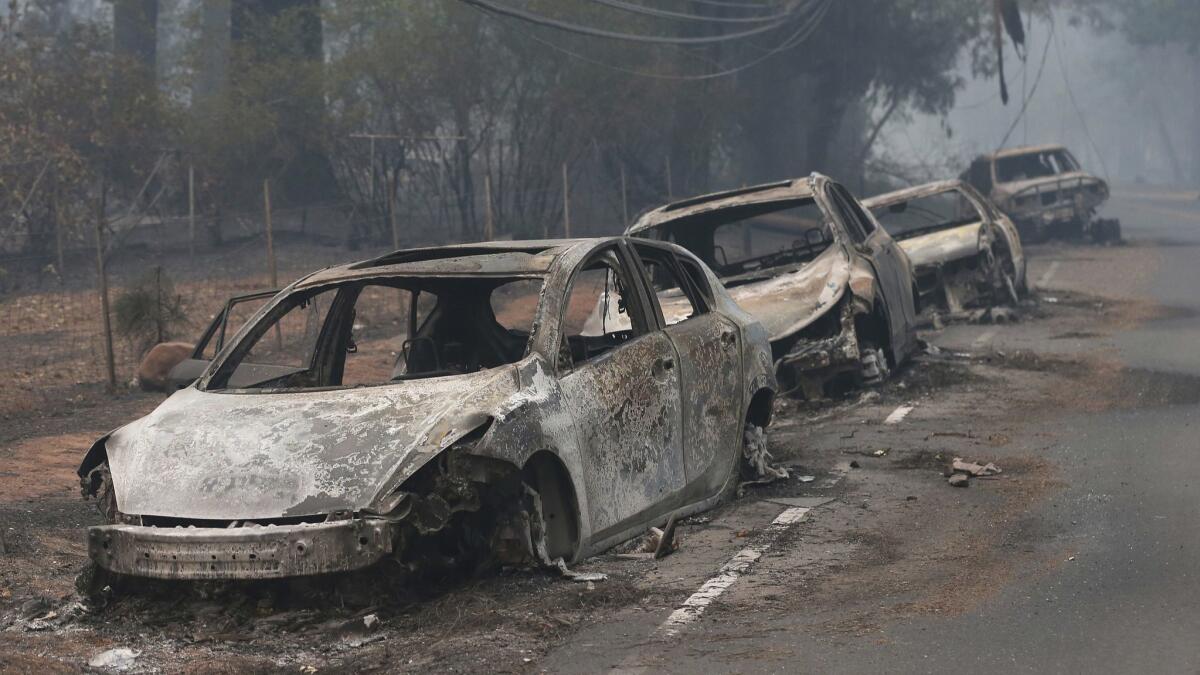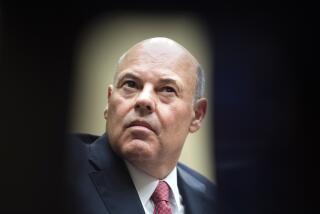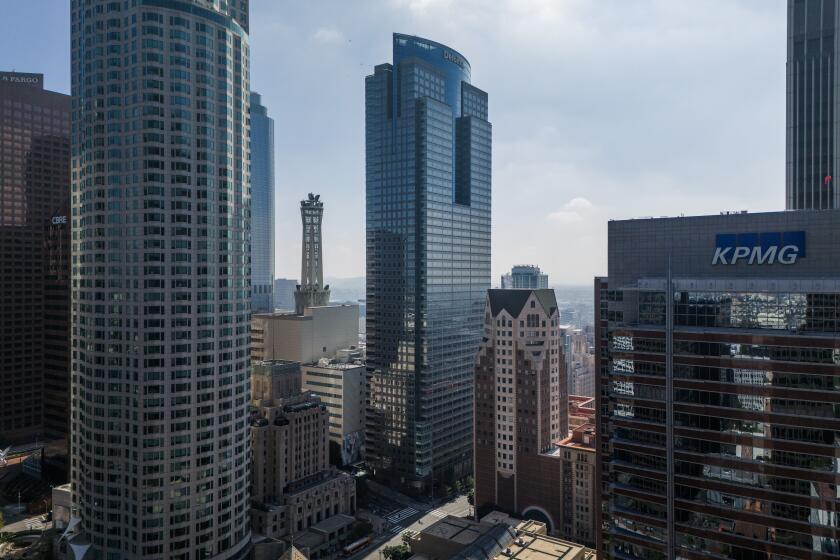Column: California utilities use wildfires as an excuse to wring ratepayers dry

It always was predictable that California’s utilities would ask for a heap of government assistance to cover their financial liabilities resulting from two years of epic wildfires.
What wasn’t so predictable was how deep they would try to reach into their customers’ pockets.
Now we know. As my colleague Sammy Roth has reported, Southern California Edison, Pacific Gas & Electric and San Diego Gas & Electric are asking state and federal regulators to saddle their ratepayers with massive rate increases. The companies all assert that they need a higher rate of return — that is, higher rates — to attract investors to businesses that suddenly seem riskier than ever.
The regulators’s task here is obvious. They should just say no.
Let’s start with the utilities’ rate requests, which are outrageous by any measure.
Rate requests are the beginning of a conversation.
— Utility expert Steven Weissman
Edison is seeking an increase from the state Public Utilities Commission of more than 6% in its allowable return on equity, which would result in a 12.2% increase in its average customer’s monthly bill —$12.20 a month on an average bill of $100. That’s on top of a rate increase averaging $2.20 a month that Edison previously requested from the Federal Energy Regulatory Commission.
PG&E is asking state regulators for an average residential electric increase of $7.85 a month, or 7%. Gas customers would face an increase of $4.25 a month, or 7.7%. Sempra, the parent of SDG&E, is seeking an increase amounting to an average of $5.59 a month.
The utilities acknowledge that much of this money would go into investors’ pockets. Edison, in announcing its rate request, called the increase “a near-term necessity in order to attract the capital needed to provide safe, reliable electricity” — in other words, to lure investors.
It’s probable, of course, that the utilities are high-balling the regulators — they’re hoping the PUC will split the difference and award them rate increases that aren’t outrageous, merely egregious.
“Rate requests are the beginning of a conversation” with regulators, says Steve Weissman, a former PUC administrative law judge who now teaches at the UC Berkeley law school. “The utilities clearly are perceiving that they’re riskier than they were before, but it’s up to the regulators to decide whether that’s a legitimate concern and to figure out what the appropriate return may be.”
There’s no question that the physical landscape has shifted under the companies’ feet. Climate change appears to be leading to longer and more intense wildfire seasons. That’s a problem for the companies, because their power lines crisscross fire zones, and the utilities’ inattention to vegetative growth near their lines leads to fire-causing sparks. State authorities have blamed some of the most damaging fires on utility operations, with the causes of major recent fires still undetermined.
The utilities’ hopes of sticking ratepayers with the costs of those fires were dealt a major blow in November 2017, when a PUC judge rejected SDG&E’s bid to pass $379 million in expenses from three 2007 wildfires to its ratepayers. The judge found that the utility had failed to “reasonably manage and operate its facilities” prior to the blazes. If the ruling stands, SDG&E’s shareholders will be on the hook.
PG&E, meanwhile, has conceded that its equipment probably caused last November’s Camp fire, the deadliest in the state’s history, which took at least 86 lives, destroyed nearly 19,000 structures and turned the town of Paradise into ash.
Yet whether these circumstances necessarily mean the utilities will be toxic unless they can mulct their customers for double-digit rate increases is highly questionable. The threat of fire liability has been looming for at least a couple of years, but investors haven’t been running for the hills. Edison hasn’t exactly suffered over the last year from its exposure; the company’s stock closed at a dividend-adjusted $62.35 one year ago, and $64.20 on Wednesday. Investors receive a dividend of $2.45 per share, for a 4.09% dividend yield at Wednesday’s closing.
Pacific Gas & Electric investors haven’t done very well — its shares have lost more than half their value in the past year, closing Wednesday at $22.93. But PG&E is a special case, as it filed for bankruptcy on Jan. 29.
In the days prior to the filing, PG&E traded as low as $6.36, but its shares have nearly quadrupled in price since then. In any case, their low value may have as much to do with investors’ perception that the chickens finally are coming home to roost after years of atrocious management at PG&E; this is a company battling not only wildfires, but the consequences of lethal incompetence that killed eight people and leveled an entire community in a 2010 gas pipeline explosion. (PG&E, being in bankruptcy, doesn’t pay a dividend.)
As for Sempra, its shares have gained nearly 20% over the past year, closing Wednesday at $126.41. It’s still rewarding shareholders with a $3.87 per share annual dividend, or 3.07% at the current price.
What may be helping to keep these shares afloat is investors’ recognition that despite their challenges, California’s big utilities still have advantages that conventional corporations don’t. Since they’re each a monopoly in their service areas, they have captive markets. State officials have a powerful incentive to not let them fail, because ratepayers are almost as likely to blame brownouts and blackouts on their politicians as on their utilities.
The state legislature has already acted to help the companies manage wildfire costs, with more assistance probably on the way. The legislature last year enacted a measure easing the conditions under which the PUC might allow the companies to charge ratepayers for wildfire costs, and allowed ratepayer costs to be spread out over years via bonds.
Weissman, in an April 12 memo to Gov. Gavin Newsom, outlined the economic risks if the utilities are left to shoulder alone all the costs of climate change, including increased wildfire risk: Rates could skyrocket by 50% in a year, threatening the consumer shift to electric vehicles and making California businesses uncompetitive with out-of-state firms.
But that argues in favor of a broad solution to the problem, not allowing the utilities to gouge their consumers for everything they can get. The risk there is that California consumers would end up paying the full price of climate change. That wouldn’t be proper or just. If the utilities’ latest rate requests are the beginning of a conversation, the regulators’ first response should be to tell the companies to sharpen their pencils and redo their math.
Keep up to date with Michael Hiltzik. Follow @hiltzikm on Twitter, see his Facebook page, or email michael.hiltzik@latimes.com.
Return to Michael Hiltzik’s blog.
More to Read
Inside the business of entertainment
The Wide Shot brings you news, analysis and insights on everything from streaming wars to production — and what it all means for the future.
You may occasionally receive promotional content from the Los Angeles Times.











